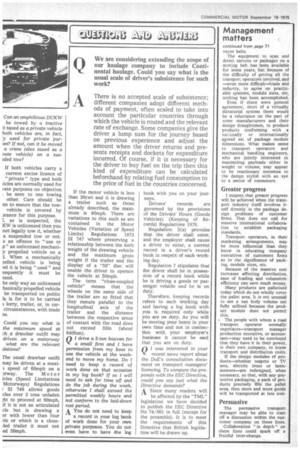Can an amphibious DUKW be towed by a tractive :t
Page 74

If you've noticed an error in this article please click here to report it so we can fix it.
taxed as a private vehicle both vehicles are, in fact, 'y used for private pur;es? If not, can it be moved a crane (a/so taxed as a vote vehicle) on a susEded tow?
If bath vehicles carry a current excise licence of " private" type and both tides are normally used for rate purposes no objection be seen to one towing other. Care should be en to ensure that the towvehicle is covered by trance for this purpose. as is suspected, the KW is unlicensed then you not legally tow it, whether a suspended tow or not. s an offence to "use or p" an unlicensed mechaniy propelled vehicle on a J. When a mechanically elled vehicle is being ed it is being " used " and sequently it must be nsed.
he only way an unlicensed hanically propelled vehicle be transported on public Is is for it to be carried lorry, trailer, or, in cercircumstances, with trade es.
Could you say what is the maximum speed at 2h a drawbar outfit may driven on a motorway what are the relevant !lotions?
The usual drawbar outfit may be driven at a maxia speed of 60mph on a Drway. The Motor idles (Speed Limitations Motorways) Regulations SI 748 allows goods cies over 3 tons unladen ;ht to proceed at 60mph, if it is not an articulated cle but is drawing a er with fewer than four als or which is a close'led trailer it must not ed 50mph. If the motor vehicle is less than 30cwt and it is drawing a trailer such as those already described, the maximum is 40mph. There are variations to this such as are contained in the Motor Vehicles (Variation of Speed Limits) Regulations 1973 SI 747 where preserving a relationship between the kerb weight of the drawing vehicle and the maximum gross weight if the trailer and the display of a "50" disc will enable the driver to operate the vehicle at 50mph.
The term "close-coupled vehicle" means that the wheels on the same side of the trailer are so fitted that they remain paiallel to the longitudinal axis of the trailer and the distance between the respective areas of contact with the road does not exceed 33in (about 840fnm).
QI drive a 5-ton hoxvan for a small firm and I have permission from my boss to use the vehicle at the weekend to move my home. Do I need to keep a record of work done on that occasion in my log book? If so I will need to ask for time off and do the job during the week, otherwise I shall exceed the permitted weekly hours and not conform to the laid-down rest period. A You do not need to keep • a record in your log book of work done for your own private purposes. You do not even have to have the log book with you on your journeys, Drivers' records are governed by the provisions of the Drivers' Hours (Goods Vehicles) (Keeping of Records) Regulations 1970.
Regulation 3(a) provides that the driver shall enter, and the employer shall cause a driver to enter, a current record in a driver's record book in respect of each working day.
Regulation 7 stipulates that the driver shall be in possession of a record book while he is driving a goods or passenger vehicle and he is on duty.
Therefore, keeping records refers to each working day and having a log book with you is required only whileyou are on duty. As you will be moving your home in your own time and not in connection with your employer's business it cannot be said that you are on duty.
QI was interested in your recent news report about the DoE's consultation document on transport managers' licencing. To compare the proposals with the EEC Directive, could you say just what the Directive demands? A Since many readers will be affected by the "TML" legislation we have decided to publish the EEC Directive No 74/561 in full (except for the preamble). It is to meet the requirements of this Directive that British legislation will be drawn up.
















































































































